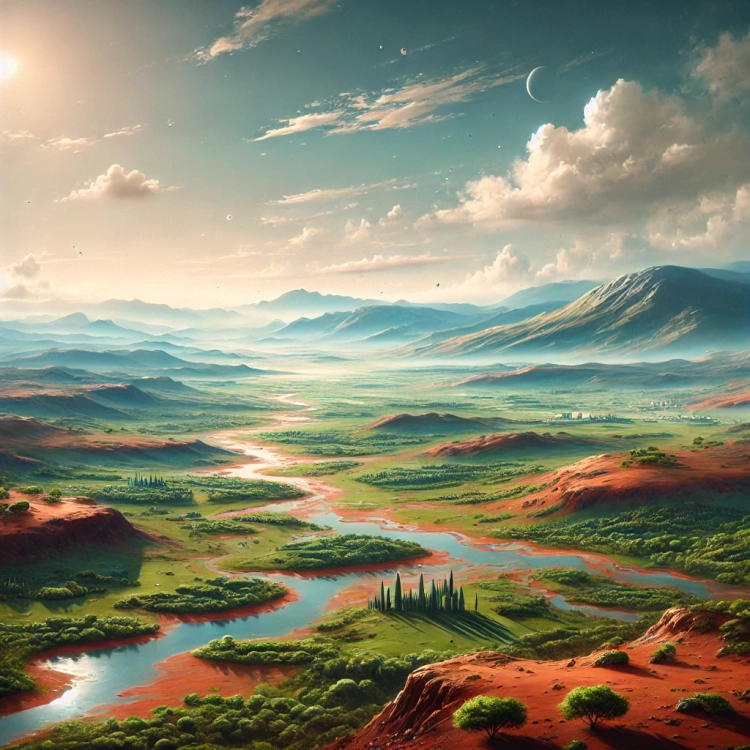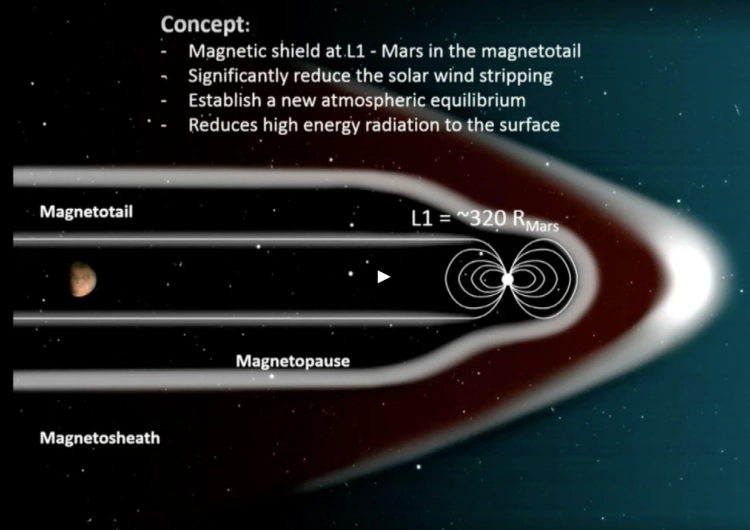

Imagine standing on a barren, red plain, the sky a dusty ochre. Your breath forms tiny puffs of mist inside your helmet as you peer out across the lifeless expanse. The idea that this desolate world could one day teem with life—lush green valleys, flowing rivers, and forests swaying under a bright Martian sun—seems like pure science fiction. Yet, transforming Mars into a second Earth isn’t as far-fetched as it might seem. The process of terraforming—the grandest engineering project humanity has ever conceived—could one day turn this dream into reality.
Let’s take a journey through the steps of what it might take to transform Mars, a planet that’s cold, dry, and hostile to human life, into a world where people could walk, breathe, and thrive without spacesuits. This isn’t just an adventure in imagination—it’s a concept rooted in real science, with challenges and possibilities that could reshape the future of our species.
Why choose Mars as humanity’s next great frontier? The answer lies in its similarity to Earth. Mars, with its 24.6-hour day and seasonal cycles, is more akin to our own planet than any other world in our solar system. Ancient riverbeds crisscross its surface, and deep valleys hint at a past where water flowed freely. Scientists believe that billions of years ago, Mars had a thicker atmosphere and was warm enough to support liquid water—possibly even oceans. But over time, it lost its atmosphere and much of its water, transforming into the frozen desert we see today.
If Mars was once habitable, could it be made so again? That’s where the concept of terraforming comes in: a series of grand-scale engineering feats designed to warm the planet, thicken its atmosphere, and perhaps even jump-start a new ecosystem.

The first challenge in terraforming Mars is its temperature. The average surface temperature hovers around -63°C (-81°F)—far too cold for liquid water to exist. To change this, scientists have proposed various methods to warm the planet.
One idea involves placing gigantic mirrors in orbit around Mars. These mirrors, made of thin reflective material, would focus sunlight onto the surface, gradually raising the temperature. Picture a series of massive, shimmering disks floating high above the planet, bathing specific regions in concentrated warmth. As the ground warms, it would release the frozen carbon dioxide (CO₂) trapped in the ice caps. This CO₂ would seep into the atmosphere, creating a greenhouse effect that traps heat and amplifies the warming process.
Another, more radical proposal suggests releasing powerful greenhouse gases like sulfur hexafluoride or chlorofluorocarbons (CFCs) into the atmosphere. These gases, thousands of times more effective at trapping heat than CO₂, could potentially jump-start a runaway greenhouse effect. But producing enough of these gases would require an industrial effort on an unprecedented scale—factories dotting the Martian landscape, tirelessly churning out gas after gas, feeding the atmosphere like a cosmic furnace.
And then there’s Elon Musk’s controversial idea: detonating nuclear bombs over the polar ice caps. The resulting explosions would vaporize the ice, releasing CO₂ and water vapor into the atmosphere in a single, cataclysmic event. It’s a bold strategy, but it comes with risks—such a drastic action could trigger unpredictable consequences, like global dust storms that might plunge the planet into a “nuclear winter” instead of warming it.
As Mars warms, the CO₂ released from the polar ice caps would start to thicken the atmosphere, creating a positive feedback loop. But Mars’s atmosphere would still be far too thin for humans to breathe or even survive without a pressure suit.
Scientists estimate that melting all the ice on Mars could increase the atmospheric pressure to around 19 kPa (2.8 psi). For comparison, Earth’s sea-level pressure is 101 kPa (14.7 psi). At this point, you still wouldn’t be able to take off your helmet, but you might only need a breathing mask, similar to what climbers use in the thin air atop Everest.
To push the pressure higher, other gases would need to be added to the atmosphere. One potential candidate is nitrogen, a key component of Earth’s air. Where could we find this nitrogen? In frozen form, on asteroids scattered throughout the outer solar system. Imagine spacecraft capturing these space rocks, redirecting them toward Mars, and releasing their payload of frozen ammonia upon impact. As the ammonia breaks down, it would release nitrogen, helping to thicken the atmosphere even more.
Creating a breathable atmosphere is only part of the challenge. Mars’s lack of a global magnetic field means that any atmosphere we build would be vulnerable to being stripped away by the solar wind—a continuous stream of charged particles ejected by the Sun. Without protection, Mars would slowly lose its newly thickened atmosphere, just as it did billions of years ago.
To solve this, scientists have proposed creating an artificial magnetic field to shield Mars. The idea is to position a giant magnetic shield at Mars’s Lagrange point, a spot in space where the gravitational pull of Mars and the Sun balance out. This magnetic field, generated by superconducting rings or a large plasma torus, would deflect the solar wind, protecting the planet’s atmosphere and surface from harmful radiation.

Imagine a vast, glowing shield in space, like an ethereal dome of energy surrounding the planet. As sunlight glints off the surface of Mars, this magnetic bubble would shimmer faintly, a protective barrier against the relentless bombardment of cosmic radiation. It’s an ambitious idea, but it could be the key to maintaining a stable atmosphere on Mars and making it a true second Earth.
With a thicker, warmer atmosphere, liquid water could begin to reappear on Mars’s surface. The ice at the poles and hidden beneath the ground would melt, forming rivers, lakes, and perhaps even shallow seas. But more water would likely need to be imported to create a truly Earth-like environment.
One idea is to redirect icy comets from the outer solar system toward Mars. Picture a massive space mission—a fleet of robotic ships herding comets, gently steering them through the vastness of space and crashing them into Mars. As these icy bodies disintegrate, they would release vast amounts of water vapor, which would condense and fall as rain. Imagine the first Martian rainstorm: a deluge of water falling from the sky, carving new rivers and filling basins that had been dry for billions of years.
With warmth, air, and water in place, Mars would be ready for the next step—introducing life. Hardy plants like lichens and algae would be among the first pioneers, capable of surviving in harsh conditions and slowly producing oxygen through photosynthesis. Over centuries, as oxygen levels rise, more complex plants could be introduced, eventually creating the foundations for a new Martian ecosystem.
But this isn’t a process that would happen overnight. It would take centuries, perhaps even millennia, for Mars to become truly Earth-like. There would be setbacks, and perhaps we’d discover unforeseen challenges. Yet, the thought of one day walking through a Martian forest, breathing in the crisp, cold air of an alien world, is enough to inspire generations of scientists and dreamers.
Yet, even as we dream of terraforming Mars, there are serious questions to consider. What if there’s already life on Mars, hidden beneath the surface? Would we be destroying a unique biosphere, snuffing out an alien species before we even discover it? Is it ethical to reshape an entire planet for our own purposes, just because we have the power to do so?
Terraforming Mars isn’t just a question of engineering—it’s a question of philosophy, ethics, and our place in the universe. Are we caretakers of the cosmos, responsible for preserving it as we find it? Or are we explorers, destined to shape new worlds in our own image, spreading life throughout the solar system?
These are questions we’ll need to answer before we take our first steps toward making Mars a second home. But one thing is certain: the dream of terraforming Mars has captured our imagination, and the adventure of turning that dream into reality is only just beginning.
For now, Mars remains a red beacon in the night sky, a reminder of our desire to reach for the stars and transform them. Whether we do so for survival, curiosity, or the sheer thrill of discovery, Mars will always be there—waiting for us to write the next chapter of its story.